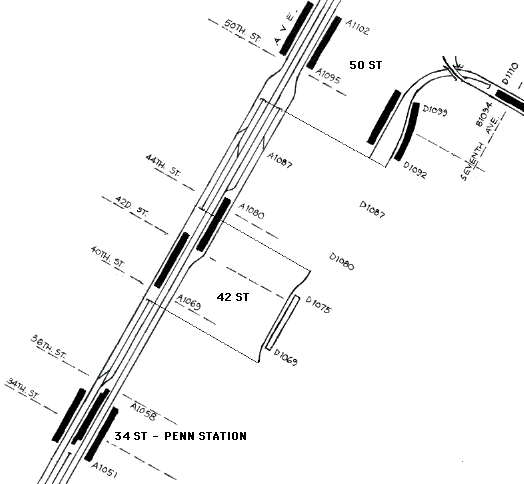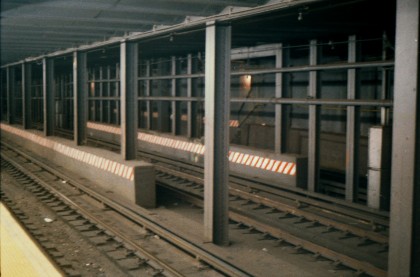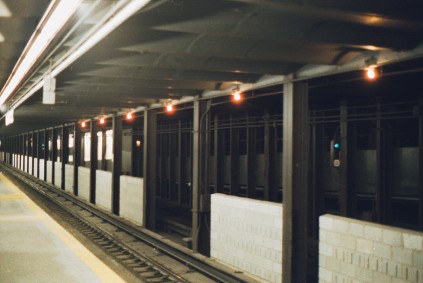

|
by Joseph Brennan. Copyright 2001, 2002. |
42 St lower levelPassenger service: September 1959 - March 1981.Existing abandoned portions: 1 platform (on 1 track not in passenger service). Touring: A C E trains to 42 St. The platform is below the downtown open platform, but it can't be seen from there. construction and operation42 St was on the first portion of the Independent (IND) subway, opened in September 1932. The lower level was built together with the station but was not used for some time. The single track running through it is properly part of the track running from Queens via 53 St, chained as route D of the system. It's not clear why the lower level was built. In train operation, merge points are the biggest cause of delay, and the lower level does make it possible to bring trains from Queens as far as 42 St lower before a merge point south of the station. It might have been considered desirable to hold a train at 42 St, a destination point for some riders. In reality, train E from Queens has almost always been merged at the switch provided north of 42 St, holding at 50 St lower level if necessary. The lower level appears to block off the IRT Queensborough line in 41 St (7 train) which is at about the same level and extends to 8 Ave (although the end of its Times Square station is a few hundred feet east in 41 St). The lower level was not actually opened until 1959, and was not completed with tile and signs until then either. It was opened because it provided a place to start special extra-fare trains to Aqueduct Racetrack. The racetrack is on the Rockaway line, a former Long Island Railroad line opened as a subway line in 1956, when the racetrack was closed for reconstruction. In September 1959, a special Aqueduct Racetrack station was opened, and special trains from 42 St lower level began operating, stopping only at Hoyt-Schermerhorn Sts and running fast on the express track in Brooklyn. The racetrack service ended in 1981. For some time in the 1970's, the lower level was used for downtown train E in the evening rush hour. Stairways to the lower level at the near ends of the uptown and downtown platforms were open for many years as the only way to cross between platforms. When the free transfer to Times Square station was opened, the mezzanine above was rearranged and the crossunder was closed as unneeded and less safe. The two stairways are behind temporary plywood walls as of mid 2001 and probably will be closed up. The two escalators directly from the mezzanine past the main platform to the lower level have been enclosed, and no stairways down are publicly visible. |
diagram |

|
Route A is the 8 Ave subway; chaining for route D to Queens starts at the switch near 36 St and runs through 42 St station lower level. The single track comes up to main level north of 42 St station and then two tracks descend to 50 St lower and on to Queens. |
|
The former stairways to the lower level are being removed. The one near the downtown end of the downtown platform has been replaced by a metal hatch. The newer floor around the hatch has almost blended in with the surrounding concrete. Once it's tiled over, only the hatch will remain as evidence. |
|
|

|
From the downtown platform, this view shows the downtown express track and beyond it the uptown and local tracks. It looks like there is a bridge over something, where the tunnel crosses 41 St. That length of concrete at the base of the columns, between the tracks, appears to be covering a beam supporting those columns. Such a beam would span an open space below. Is this the end of the IRT Queensborough line, crossing under at a right angle, running right up to the edge of the lower level, which is under the platform here? |
|
|

|
At the opposite end of the station, a thousand feet north, this view from the end of the uptown platform shows the express tracks, and just beyond them, the inclined ceiling over the track running down to the lower level. |

|
|
|